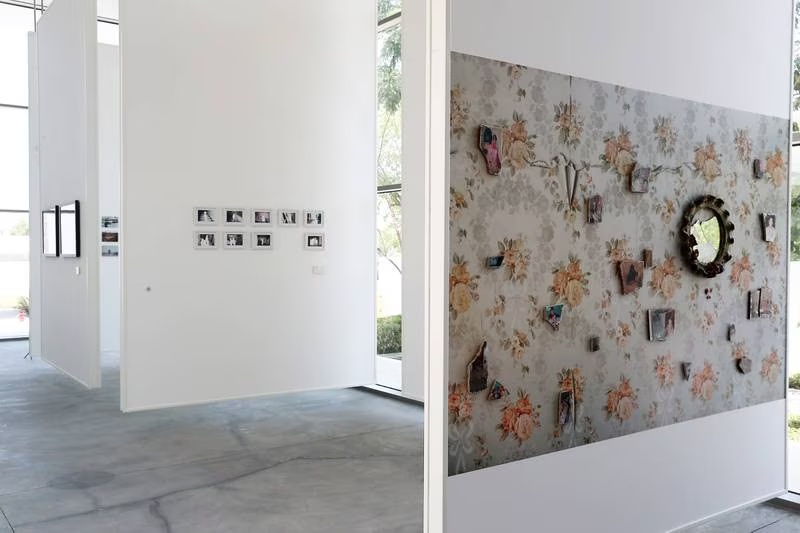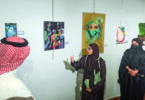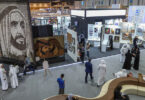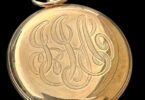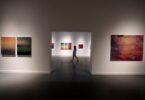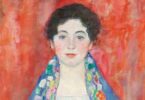Maan Jalal
A man immersed in lavender light stands in front of a blank canvas with a poignant observant gaze.
The man’s kandura is painted with expressive brush strokes and the sparse details of his unfastened collar reveal the skilled use of line, light and colour.
The work is a self-portrait by the celebrated Emirati artist Abdul Qader Al Rais. Painted in 1973, it’s a captivating piece to welcome the public into Al Safa Art and Design Library’s latest exhibition.
Entitled Time & Identity, the exhibition is a showcase and celebration of 50 years of Emirati art, revealing the breadth and diversity of perspectives from 22 Emirati artists across generations.
“It’s always been important to include Emirati art in Emirati spaces in Dubai and the UAE,” Sheikh Maktoum Marwan Al Maktoum, the exhibition’s project manager tells The National.
The exhibition is supported by Dubai Culture and Arts Authority event Sikka Art and Design Festival, which Sheikh Maktoum says “aims to create a sustainable ecosystem for artists and creators in the region, the foundation of that, is Emirati artists.”
:quality(70)/cloudfront-eu-central-1.images.arcpublishing.com/thenational/WGVY4XVQJRD6BHKUIEJFPOUQ34.jpg)
Time & Identity is an extension of that ethos, providing a platform for artistic dialogue and exchange not only among visitors and artists but particularly between Emirati artists of different generations.
“We are creating an exhibition hoping to build bridges between these generations, encourage cross generational discussions, and hopefully plant seeds for future opportunities,” he says.
“It’s also important for the visitor to see what Emirati art is and what it can be.”
The 22 artists featured explore the theme across various mediums including painting, print, digital art, sculpture, mixed media and more.
:quality(70)/cloudfront-eu-central-1.images.arcpublishing.com/thenational/CHNCRRCGC5CB5OPIPO4HBY6YGU.jpg)
Spread across several spaces in the L-shaped gallery, separated by semi-permanent walls, the works are curated in an organic fashion. While not adhering to any type of chronology and not separated by styles or movements, the works speak to each other through the shared exploration of concepts and themes.
Renowned contemporary artist Mohammed Kazem’s piece Inkjet Print on Paper and Mohamed Yousif’s sculptural piece My Small Naashaat appear alongside works by young artists using new mediums, such as Maitha Demithan whose piece Artificial Portraits documents her exploration of artificial intelligence.
There is a stunning series of work by Asmaa Balhamr entitled Souq Al Ras Façade Observation and El Ebrahimi Building Observation which investigates, through intricate drawings, the influence of Emirati architecture on the landscape.
Another series of engaging monochromatic scenes entitled Hallucinogenic Facade: Starting Point by Safeya Sharif was made by blind embossing on paper, playing with ideas and imagery that blur the lines between imagination and reality.
:quality(70)/cloudfront-eu-central-1.images.arcpublishing.com/thenational/HLMTNNWFKBGAFJBCTEQCXIBFCE.jpg)
Juma Al Haj’s painting Loose Leaf is engrossing for his skilful use of layering and detailing. He explores spiritual experiences derived from texts such as ancient religious texts, personal diaries and letters evoking longing, solace or nostalgia.
Sheikh Maktoum believes the exhibition is part of a greater dialogue around how Emirati artists can learn from each other’s practices and experiences.
“The most refreshing thing about the exhibition was seeing the different artists of various simulations, discussing their work, finding commonalities and their concepts amongst each other,” he says.
“It’s important for Emiratis to see themselves reflected in the works. It’s also important for visitors to see the commonalities we have amongst each other and with them.”
As viewers explore the spaces in the gallery, they are introduced to various artists’ points of view and aesthetics but, most importantly, a clear display of the diversity of Emirati artists’ voices.
While the aim isn’t necessarily to educate but to celebrate Emirati art, it’s impossible to leave the exhibition without a clearer understanding about the history of Emirati art and its future.
Courtesy: thenationalnews

